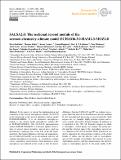| dc.contributor.author | Kokkola, Harri | |
| dc.contributor.author | Kühn, Thomas | |
| dc.contributor.author | Laakso, Anton | |
| dc.contributor.author | Bergman, Tommi | |
| dc.contributor.author | Lehtinen, Kari E. J. | |
| dc.contributor.author | Mielonen, Tero | |
| dc.contributor.author | Arola, Antti | |
| dc.contributor.author | Stadtler, Scarlet | |
| dc.contributor.author | Korhonen, Hannele | |
| dc.contributor.author | Ferrachat, Sylvaine | |
| dc.contributor.author | Lohmann, Ulrike | |
| dc.contributor.author | Neubauer, David | |
| dc.contributor.author | Tegen, Ina | |
| dc.contributor.author | Siegenthaler-Le Drian, Colombe | |
| dc.contributor.author | Schultz, Martin G. | |
| dc.contributor.author | Bey, Isabelle | |
| dc.contributor.author | Stier, Philip | |
| dc.contributor.author | Daskalakis, Nikos | |
| dc.contributor.author | Heald, Colette L. | |
| dc.contributor.author | Romakkaniemi, Sami | |
| dc.date.accessioned | 2020-08-17T16:05:43Z | |
| dc.date.available | 2020-08-17T16:05:43Z | |
| dc.date.issued | 2018-09 | |
| dc.date.submitted | 2018-08 | |
| dc.identifier.issn | 1991-9603 | |
| dc.identifier.uri | https://hdl.handle.net/1721.1/126621 | |
| dc.description.abstract | In this paper, we present the implementation and evaluation of the aerosol microphysics module SALSA2.0 in the framework of the aerosol-chemistry-climate model ECHAM-HAMMOZ. It is an alternative microphysics module to the default modal microphysics scheme M7 in ECHAM-HAMMOZ. The SALSA2.0 implementation within ECHAM-HAMMOZ is evaluated against observations of aerosol optical properties, aerosol mass, and size distributions, comparing also to the skill of the M7 implementation. The largest differences between the implementation of SALSA2.0 and M7 are in the methods used for calculating microphysical processes, i.e., nucleation, condensation, coagulation, and hydration. These differences in the microphysics are reflected in the results so that the largest differences between SALSA2.0 and M7 are evident over regions where the aerosol size distribution is heavily modified by the microphysical processing of aerosol particles. Such regions are, for example, highly polluted regions and regions strongly affected by biomass burning. In addition, in a simulation of the 1991 Mt. Pinatubo eruption in which a stratospheric sulfate plume was formed, the global burden and the effective radii of the stratospheric aerosol are very different in SALSA2.0 and M7. While SALSA2.0 was able to reproduce the observed time evolution of the global burden of sulfate and the effective radii of stratospheric aerosol, M7 strongly overestimates the removal of coarse stratospheric particles and thus underestimates the effective radius of stratospheric aerosol. As the mode widths of M7 have been optimized for the troposphere and were not designed to represent stratospheric aerosol, the ability of M7 to simulate the volcano plume was improved by modifying the mode widths, decreasing the standard deviations of the accumulation and coarse modes from 1.59 and 2.0, respectively, to 1.2 similar to what was observed after the Mt. Pinatubo eruption. Overall, SALSA2.0 shows promise in improving the aerosol description of ECHAM-HAMMOZ and can be further improved by implementing methods for aerosol processes that are more suitable for the sectional method, e.g., size-dependent emissions for aerosol species and size-resolved wet deposition. | en_US |
| dc.description.sponsorship | NOAA (Grant NA17RJ1231) | en_US |
| dc.description.sponsorship | National Science Foundation (Grant ATM-0002035, ATM-0002698 and ATM04-01611) | en_US |
| dc.language.iso | en | |
| dc.publisher | Copernicus GmbH | en_US |
| dc.relation.isversionof | http://dx.doi.org/10.5194/gmd-11-3833-2018 | en_US |
| dc.rights | Creative Commons Attribution 4.0 International license | en_US |
| dc.rights.uri | https://creativecommons.org/licenses/by/4.0/ | en_US |
| dc.source | Copernicus Publications | en_US |
| dc.title | SALSA2.0: The sectional aerosol module of the aerosol–chemistry–climate model ECHAM6.3.0-HAM2.3-MOZ1.0 | en_US |
| dc.type | Article | en_US |
| dc.identifier.citation | Kokkola, Harri et al. "SALSA2.0: The sectional aerosol module of the aerosol–chemistry–climate model ECHAM6.3.0-HAM2.3-MOZ1.0." Geoscientific Model Development 11, 9 (September 2018): 3833–3863 © 2018 Author(s) | en_US |
| dc.contributor.department | Massachusetts Institute of Technology. Department of Civil and Environmental Engineering | en_US |
| dc.contributor.department | Massachusetts Institute of Technology. Department of Earth, Atmospheric, and Planetary Sciences | en_US |
| dc.relation.journal | Geoscientific Model Development | en_US |
| dc.eprint.version | Final published version | en_US |
| dc.type.uri | http://purl.org/eprint/type/JournalArticle | en_US |
| eprint.status | http://purl.org/eprint/status/PeerReviewed | en_US |
| dc.date.updated | 2020-05-27T17:30:37Z | |
| dspace.date.submission | 2020-05-27T17:31:01Z | |
| mit.journal.volume | 11 | en_US |
| mit.journal.issue | 9 | en_US |
| mit.license | PUBLISHER_CC | |
| mit.metadata.status | Complete | |
